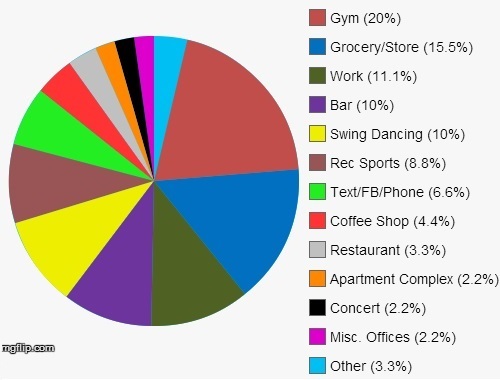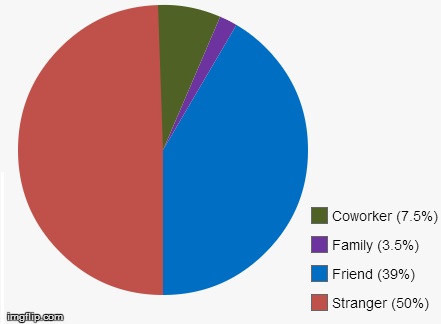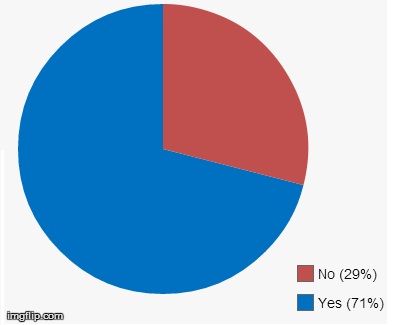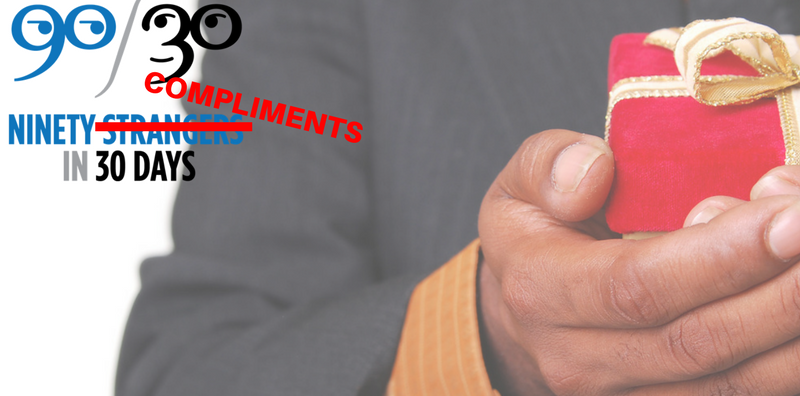
Recap and Results
This post is part of a 30-day social experiment that focused on giving more compliments. Also check out the rules and guidelines, my five big takeaways, and the related reddit post.
—
Overall Thoughts
The first thing that became apparent about the experiment was that it just wasn’t that challenging…at first.
After realizing that complimenting three strangers a day for a month wasn’t that difficult a thing to do, I had admittedly written off my own project after the first week. As a result, I did not put in as much effort or creativity as I probably should have.
I knew I would finish the project, that I’d have some kind of takeaway, and plenty to write about. But I still had quickly chalked up 90 Compliments as only something that would be a great precursor or warm up for someone who found 90 Strangers extremely difficult.
That said, towards the end of the month I started to re-gain interest in my own project as I tried to push myself beyond the low-hanging compliment fruit of “I like your shirt”, “Great job with X”, and so on. I had failed to see in the beginning how much possibility there was with complimenting people and making them feel good. This upswing of optimism has made me consider about continuing or re-doing the experiment someday simply for the sake of doing so.
Like last time, I kept track of the data—the details of all 90 compliments, age, gender, demographic, location, relationship to me, and whether or not a conversation ensued—in a spreadsheet which is available here as a PDF:
The 90 Compliments in 30 Days Data Sheet
—
Data Breakdown
Below are some graphs and summaries of everything I kept track of, as well an examination of my predictions and some Q&As about the experiment.
Age

<13: 2 (.02%)
Teens: 2 (.02%)
20s: 58 (64%)
30s: 19 (21%)
40s: 7 (.07%)
50s: 1 (.01%)
60s: 1 (.01%)
This surprised me slightly–I knew that for the most part I hung around and gravitated towards people my own age (like most I am sure).
However, if you had asked me beforehand to predict these numbers I feel I would have been way off; I think I would have expected myself to shy away somewhat from complimenting my peers as opposed to those that are older or younger.
In hindsight, I don’t think I had any real anxiety about complimenting any age group in particular—I basically just spoke to whoever was around.
Funny enough, when people ask me what I don’t like about where I currently live, I usually say there aren’t enough my people my age—whoops.
Gender
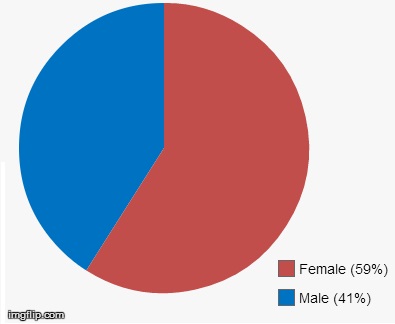
Male: 37 (41%)
Female: 54 (59%)
*was one instance where I congratulated a newly-engaged couple which I gave a tally to each gender for, hence this not adding up to 90
About what I expected and not that surprising. Also to be fair, swing dancing and my place of work are very female-laden.
Demographic

F20s: 36 (39.5%)
M20s: 23 (25.2%)
F30s: 10 (10.9%)
M30s: 9 (.09%)
F40s: 5 (.05%)
M40s: 2 (.02%)
M<13: 2 (.02%)
F50s: 1 (.01%)
F60s: 1 (.01%)
FTeens: 1 (.01%)
Again, I’m a single straight male in my twenties; probably not that surprising. Beyond that, for the most part a trend continues in that the closer someone is to my age, the more I complimented them. Again, also reflective of who I surround myself with most.
*same footnote as above applies here
Location
Gym: 18 (20%)
Grocery/Other Store: 14 (15.5%)
Work: 10 (11.1%)
Bar: 9 (10%)
Swing Dancing: 9 (10%)
Rec Sports (soccer, kickball, and paintball): 8 (8.8%)
Coffee Shop: 4 (4.4%)
Restaurant: 3 (3.3%)
Text: 3 (3.3%)
Apartment Complex: 2 (2.2%)
Concert: 2 (2.2%)
Phone: 2 (2.2%)
Airport/Shuttle: 2 (2.2%)
Car Rental Office: 1 (1.1%)
Accountant’s Office: 1 (1.1%)
Facebook Message: 1 (1.1%)
Friend’s House: 1 (1.1%)
Gas Station: 1 (1.1%)
Waterpark: 1 (1.1%)
*some categories were consolidated for the chart
A little bit of everything; a small correlation can probably be drawn between the number of compliments versus how social these locations are (my gym is a super social and supportive community).
On the contrary, I hardly complimented anyone at all in places like my apartment complex where it is less of a norm to talk to people in passing.
Relationship
Stranger: 45 (50%)
Friend: 35 (39%)
Coworker: 7 (7.5%)
Family: 2 (2.5%)
Friend here is defined as anyone that I have met or been introduced to prior to the “compliment interaction”–people at my gym, that I see at swing dancing regularly, etc.
I live 1,200 miles from my most of my family, so complimenting them wasn’t something I could do that regularly since we only communicate via text and phone.
I thought I would have complimented my coworkers more–I even printed out an extra staff roster to mark up and make sure I didn’t repeat anyone. And I figured the amount of strangers and friends I complimented would be close.
Did a conversation ensue?
Yes: 64 (71%)
No: 26 (29%)
My favorite stat: Almost 3/4ths of the time I complimented someone, it led to a conversation.
Granted, I’ve had a fair amount of practice starting conversations with random people in general, but after seeing this I feel I have discovered/realized a conversation starter that is nearly foolproof. And many of the nos were simply because the compliment was in passing (like while changing sides in a kickball game) and I think once or twice I simply wasn’t heard (or just not acknowledged).
—
Were my predictions accurate?
1. That the first few days would be tough: I don’t know if tough is the right word, however in the beginning days (and days where I was just feeling “off”) I definitely would go for the easier compliment as opposed to looking at people beyond the surface. That said, and as I mention later on this post, complimenting people became a much less-conscious decision towards the end of the month.
2. That I will feel at my socially strongest by the end of the month: There are lots of factors at play with this, and I am not going to sit here and write that 90 Compliments is some sort of social-confidence-super-cocktail, but…yes.
Now, those other factors could all be responsible for perpetuating one another—in June I read The Ultramind Solution by Mark Hyman, which had me make some fine-tunings to my diet (specifically things that would supposedly boost my cognitive abilities), which in turn made me feel compelled to work out more than I usually do, which in turn made me feel better and less carefree socially, which helped re-establish a core group of friends I had gotten away from over the winter, which led me to many fun social and weekend ventures…and so on. It’s a giant cycle with no beginning, however I have no doubt that 90 Compliments played at least a small part in pulling me out of the funk I was in.
Even if I weren’t planning to push myself to do bigger and bolder experiments like this the rest of my life, I think 90 Compliments as a month-long exercise would be an extremely beneficial thing to do again if I ever needed to pull myself out of a rut, or maybe just as an annual ‘social reset’ kinda thing.
3. That I will be able to compliment everyone I come across: No. One of the original rules of the experiment was to only pay people genuine compliments that I could own and believe in, and occasionally I would come across or interact with someone that for whatever reason just didn’t present me with anything to compliment them on. And that’s ok. Perhaps they were having a bad day or we just weren’t compatible people.
4. That the experiment will be fun: Despite what I wrote earlier about having a small stretch where I wasn’t super into the project, I only had a few brief moments of “why I am doing this”. Unlike in 90 Strangers where being 0 for 3 for the day at 7PM meant having to drive out to Target to try and randomly chat with whoever was around, stringing together compliments in a short period of time was easier and much more feasible to do.
As I’ll mention in the breakdown post, something happened to me during the experiment that reinvigorated my fire for the project and reminded me exactly why I was doing it.
Frequently Asked Questions
What was my general “strategy”–did I look for any particular opportunities or did I just wing it?
I don’t know if I really had one per se—there was no particular ‘trick’ with this. I simply tried to stay out of my own head and be extremely observant of other people. If there was any kind of ‘hack’ it was to just be sure and pay a compliment in any sort of “required interaction”—so a cashier at the grocer (meaning choosing to forego using an automatic checkout machine) or the bartender when getting a drink.
Did it get easier? What was the hardest part?
In the first week I admittedly thought to myself on several occasions that I had ‘maxed out’ my complimenting skills and that I wasn’t going to witness any personal change over the rest of the month.
However, towards the third and fourth weeks I started to notice that complimenting was starting to become an automated response; there was less ‘mental prep’ of: “ok, I only have one compliment for the day, I really need to find something good about this cashier to compliment them on.” I just kind of did it.
It’s hard to explain, but even in the days after the experiment concluded, there was some sort of subconscious response I felt within myself to compliment people when they had a cool outfit or I saw them do something nice for someone. Probably a sign that a habit—or the beginning stages of a real habit—are in formation.
The hardest part was truly pushing myself to go beyond just complimenting people on their material goods and show appreciation for their smile, their posture, etc. This was probably my biggest regret with the project—not going beyond the easy targets enough.
Were there any awkward moments/did you make anyone feel uncomfortable?
It’s not always possible to tell, but I can only recall one instance where the person might have felt visibly awkward (compliment #65).
I was caught admiring the eyes of a girl (who I’d now consider a friend) on one my rec sports teams and meant to say something like “that headband really brings out your eyes” (but in a way that doesn’t sound like it came from a drug store dollar novel).
While trying to think of how to say this, said girl caught my gaze, in which case I decided to blurt out “your headband makes your eyes appear crazy blue.” I received thanks (that might have been half-hearted) and we kind of shifted over to separate conversations going on around us.
That all sounds weirder than the moment actually was. Well, I think—you’d have to ask her.
But 99% of the time the compliment was received with a thank you or just a conversation about the topic at hand. I swear.
If I did the project again, what I would do differently?
Try harder from the beginning and push myself to be more creative with every compliment. Maybe up the difficulty significantly and not allow myself to compliment articles of clothing or the same thing twice–e.g., I can only pay a compliment on a shirt once, meaning I can no longer compliment anyone else on their shirt the rest of the month.
Would I recommend this challenge to someone that wants to become more social?
Absolutely.
Definitely moreso than 90 Strangers, which I think can seem too ‘open-ended’ for someone new to this kind of thing. After the last experiment I received quite a few messages asking how I started conversations; as it shows in the data, just paying someone a compliment more often than not led a conversation. There is a much more defined objective with this one as opposed to “just go talk to strangers!”
Like 90S, 90C can be scaled an infinite number of ways—just one compliment a day to start out, or ramp up the difficulty by not allowing compliments to have anything to do with clothing or physical characteristics.


